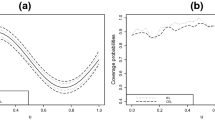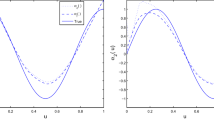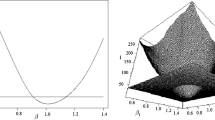Abstract
We propose a forecasting method based on a logistic curve model with missing data, which are a ubiquitous problem in social science forecasting, especially in marketing. The method completely recovers parameters of the difference equation when data are on an exact solution curve because it uses an unequal step difference equation that has an exact solution. It makes full use of data without wasting any data or generating plausible data for the missing data. It only requires regression analysis and a simple optimization technique and showed better fitting than two conventional methods for three actual datasets.






Similar content being viewed by others
References
Aggrey, S.: Comparison of three nonlinear and spline regression models for describing chicken growth curves. Poult. Sci. 81(12), 1782–1788 (2002)
Allison, P.D.: Missing data. In: Marsden, P.V., Wright, J.D. (eds.) Handbook of survey research, pp. 631–657. Emerald Group Pub. Ltd. (2010)
Gregg, J., Hossel, C., Richardson, J.: Mathematical trend curves: an aid to forecasting (Mathematical and statistical techniques for industry, monograph, no. 1). Published for Imperial Chemical Industries Ltd. by Oliver & Boyd (1964)
Gupta, R., Jain, K.: Diffusion of mobile telephony in India: an empirical study. Technol. Forecast. Soc. Change 79(4), 709–715 (2012)
Hirota, R.: Lecture on discrete equations. Saiensu-sha (2000). (in Japanese)
Inoue, S., Yamada, S.: Discrete software reliability assessment with discretized NHPP models. Comput. Math. Appl. 51(2), 161–170 (2006)
Inoue, S., Yamada, S.: Generalized discrete software reliability modeling with effect of program size. IEEE Trans. Syst. Man Cybern. Part A Syst. Hum. 37(2), 170–179 (2007)
Knízetová, H., Hyánek, J., Kníze, B., Roubícek, J.: Analysis of growth curve of fowl. I. chickens. Br. Poult. Sci. 32(5), 1027–1038 (1991)
Kucharavy, D., Guio, R.D.: Application of logistic growth curve. Procedia Eng. 131, 280–290 (2015)
Kyurkchiev, N.: Selected Topics in Mathematical Modeling: Some New Trends: Dedicated to Academician Blagovest Sendov (1932–2020). LAP LAMBERT Academic Publishing, Riga (2020)
Lechman, E.: ICT Diffusion in Developing Countries: Towards a New Concept of Technological Takeoff. Springer, Berlin (2015)
Li, T.Y., Yorke, J.A.: Period three implies chaos. Am. Math. Mon. 82(10), 985–992 (1975)
Little, R., Rubin, D.: Statistical Analysis with Missing Data. Wiley, Hoboken (1987)
Mar-Molinero, C.: Tractors in Spain: a logistic analysis. J. Oper. Res. Soc. 31(2), 141–152 (1980)
Martino, J.P.: A review of selected recent advances in technological forecasting. Technol. Forecast. Soc. Change 70(8), 719–733 (2003)
Meade, N.: The use of growth curves in forecasting market development—a review and appraisal. J. Forecast. 3(4), 429–451 (1984)
Morisita, M.: The fitting of the logistic equation to the rate of increase of population density. Res. Popul. Ecol. 7(1), 52–55 (1965)
Narinc, D., Karaman, E., Firat, M.Z., Aksoy, T.: Comparison of non-linear growth models to describe the growth in Japanese quail. J. Anim. Vet. Adv. 9(14), 1961–1966 (2010)
Okamura, H., Dohi, T.: On Kolmogorov-Smirnov test for software reliability models with grouped data. In: Proceedings 19th international conference on software quality, reliability and security (QRS2019), pp. 77–82 (2019)
Pavlov, N., Iliev, A., Rahnev, A., Kyurkchiev, N.: Some Software Reliability Models: Approximation and Modeling Aspects. LAP LAMBERT Academic Publishing, Riga (2018)
Roush, W., Branton, S.: A comparison of fitting growth models with a genetic algorithm and nonlinear regression. Poult. Sci. 84(3), 494–502 (2005)
Satoh, D.: A discrete Gompertz equation and a software reliability growth model. IEICE Trans. E83D(7), 1508–1513 (2000)
Satoh, D.: A discrete Bass model and its parameter estimation. J. Oper. Res. Soc. Jpn 44(1), 1–18 (2001). https://doi.org/10.15807/jorsj.44
Satoh, D.: Model selection among growth curve models that have the same number of parameters. Cogent Math. Stat. 6(1660503), 1–17 (2019). https://doi.org/10.1080/25742558.2019.1660503
Satoh, D.: Properties of Gompertz data revealed with non-Gompertz integrable difference equation. Cogent Math. Stat. 6(1), 1596552 (2019). https://doi.org/10.1080/25742558.2019.1596552
Satoh, D.: Property of logistic data exposed with Gompertz model and resistance to noise in actual data. Jpn. J. Ind. Appl. Math. 36(3), 937–957 (2019). https://doi.org/10.1007/s13160-019-00382-2
Satoh, D., Matsumura, R.: Monotonic decrease of upper limit estimated using Gompertz model with data described using logistic model. Jpn. J. Ind. Appl. Math. 36(1), 79–96 (2019). https://doi.org/10.1007/s13160-018-0333-9
Satoh, D., Uchida, M.: Computer worm model describing infection via e-mail. Bull. Jpn. Soc. Ind. Appl. Math. 20(3), 50–55 (2010). (in Japanese)
Satoh, D., Yamada, S.: Discrete equations and software reliability growth models. In: Proceedings of 12th International Symposium on Software Reliability Engineering, pp. 176–184. Hong Kong (2001)
Satoh, D., Yamada, S.: Parameter estimation of discrete logistic curve models for software reliability assessment. Jpn. J. Ind. Appl. Math. 19(1), 39–53 (2002). https://doi.org/10.1007/BF03167447
Skellam, J.G.: Random dispersal in theoretical populations. Biometrika 38(1/2), 196–219 (1951). https://www.jstor.org/stable/2332328?seq=1
Steffensen, J.F.: Interpolation. Dover Publications, Mineola (1950)
The World Bank: Mobile cellular subscriptions per 100 people (2018). http://databank.worldbank.org/data/country/USA/556d8fa6/Popular_countries
Ushiki, S.: Central difference scheme and chaos. Phys. D 4(3), 407–424 (1982)
Verhulst, P.F.: Notice sur la loi que la population poursuit dans son accroissement. Corresp. Math. Phys. 10, 113–121 (1838)
Yamada, S.: Software Reliability Modeling-Fundamentals and Applications. Springer, Berlin (2014)
Author information
Authors and Affiliations
Corresponding author
Additional information
Publisher's Note
Springer Nature remains neutral with regard to jurisdictional claims in published maps and institutional affiliations.
About this article
Cite this article
Satoh, D., Matsumura, R. Forecasting with full use of data without interpolation on logistic curve model with missing data. Japan J. Indust. Appl. Math. 38, 473–488 (2021). https://doi.org/10.1007/s13160-020-00452-w
Received:
Revised:
Accepted:
Published:
Issue Date:
DOI: https://doi.org/10.1007/s13160-020-00452-w
Keywords
- Logistic curve model
- Missing data
- Discrete equation
- Exact solution
- Difference equation
- Regression analysis




